How To Control Spring Garden Pests
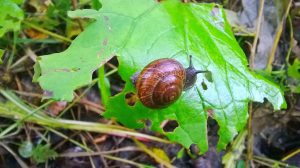
We are smack in the middle of the spring months, and garden insect pests that went into hiding by overwintering have emerged as they seek to take up residence in our gardens using plants as shelter, food and to lay their eggs as they make way for the next generation. These insect pests if left to occupy and use our gardens as a natural habitat will turn our dream gardens into a nightmare if control measures are not taken.
Whether we’re growing ornamental or edible plants, succulents, etc…. homeowners across the country including farmers, plant nurseries, and other growers are faced with these uninvited guests.
The spring months present us the opportunity to get our gardens going as the warmer months return but we must be on the lookout for these garden insect pests to bring control as soon as they come out of hiding. Below we will be discussing some of these insects pest including signs or symptoms to look for so you can put control measures in place to ensure that your garden plants continue to thrive as they grow healthy providing a good (edible garden) harvest or adding beautification to your landscapes.
7 Spring Garden Pests and How to Bring Control
Snails and Slugs

How do slugs and snails feed?
Slugs feed on dead garden animals, tender young plants, rotten matter, fungi, decomposing plants, and even paper, snails feed on the leaves of living plants, fruits, stems, barks, young tender plant roots, and flowers. The signs of slugs and snails are closely related, with slugs, you will notice a clear white smiley substance and large ragged holes in flowers and leaves of tender plants. As you continue your detective work you will also in some cases notice this clear slime on the soil surface that will give clear evidence of which direction the slug is headed.
Signs of snails may include a clear substance that leaves a trail, in some cases, it looks really gross, this substance is known as mucus and helps the snail to move over the soil surface easily. Another sign of snails in your garden is that the leaves don’t only have this mucus which some folks call slime but holes can be seen in the leaves. Slugs and snails are active from spring through fall so during this time be on the lookout for them in your garden. Slugs and snails can lay dozens of eggs up to six times per year making them very difficult to control.
Slugs and snails are active on cloudy days, at night times, or just before dawn. Places to check include under rocks, plants, old pieces of board, and other matted garden debris.
Control measures are as followed.
- Hand-picking and placing them in a bucket of water with dish detergent
- There are several baits that can be purchased but it is good to purchase those that are non-toxic
- Cultural practices have given good results. Using barriers such as sand mulches, pine nuggets, and gravel is a safe and natural way
- Using eggshells is a safe and effective method. Allow the shells to dry, crush and scatter them through your garden. The jagged edges will cut into their bodies making it really painful for them and as the eggshells break down calcium will be added to the soil
- Sprinkling coffee on the ground and around plants temporarily has offered some help
- Keep plants and soil dry as much as you can because snails and slugs are attracted by moisture. This is the condition they prefer to lay their eggs, so controlling, moisture will discourage snails.
- Snails and slugs are a good delicacy for ducks and chickens. This is a natural way to bring them under control
- Soaking a piece of board in beer will attract them. Catching and placing them in a bucket of water and dish liquid will eliminate them
Mealybugs
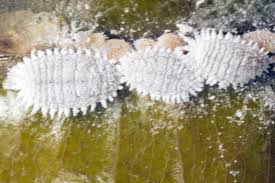
Mealybugs are insects that are covered in a white cottony wax coating, these insect pests move very slowly on the host plant. They belong to the sucking insect family. Mealybugs cause the leaves to turn yellow and then brown, after a while, the leaves fall from the plant onto the ground.
What makes matters worse is the excrement of the mealybugs attracts ants that cause sooty mold to form on the leaf surface. As a result, the plant begins to look unattractive. If there is a great build-up of sooty mold, it will interfere with the plant’s ability to make its own food.
The excrement of the mealybug is a sugary substance that ant harvest for food. Mealybugs can be found in the landscape and gardens, in plant nurseries, and also on indoor plants. Make sure that your plants are in good health by giving them the proper care to help ward off mealy bugs. Mealybugs can be controlled with insecticidal soap, horticultural oil, or neem oil.
Aphids
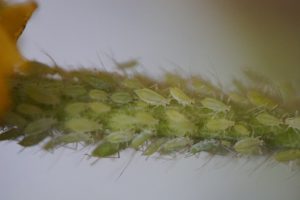
Aphids are tiny insects that are either white, brown, grey, yellow, or light green with a pear-shaped body, these insects suck the juice from the plant leaves causing discoloration and leaf drop. Leaves that have been infected by these insects curl up and grow stunted.
Aphids like mealy bugs also secrete honeydew as their excrement which attracts ants and causes sooty mold to appear on the leaf’s surface. The females lay eggs in the crevices of the twigs of the plant.
Within several days of being laid, the nymphs emerge. Nymphs are greenish but turn yellow as they mature. Aphids love to feed on the tender shoots of the host plants, flowers, fruit trees, and shrubs. I have also seen them in herb and vegetable gardens, aphids can be controlled with insecticidal soap, horticultural oil, and neem oil. A strong spray of water will also knock them off the garden plant’s casing elimination.
Scales

There are many species of scale insects worldwide, these insects can cause damage to plant life. Scales can be found in great masses in a fixed or unmovable state on garden plants. These insects are sucking insects and suck the sap from the plant.
Scales can also be found on plants that are being grown in plant nurseries, these insects are widespread and attract ants that are in search of their excrement which is a sugary substance known as honeydew.
Their excrement can also cause your plants to be covered with a black substance known as sooty mold that grows on the plants. Sooty mold causes the plant to look sickly. Scales can be controlled with insecticidal soap, horticultural oil, or neem oil.
Whiteflies
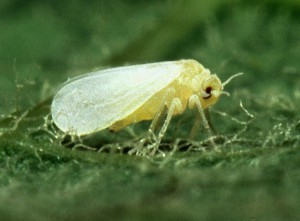
Whiteflies are tiny white insects that can cause serious damage to plant life. There was a time when our region experienced a serious outbreak of these pests that caused extensive damage to the Ficus Benjamina to the point that local plant nurseries began to give out instructions on how to control this insect.
It was a three-part instruction that I myself implemented to control these pests. Whiteflies suck the plant juices causing the yellowing of leaves and leaf drop. Because they are sucking insects they also do what other sucking insects do, to find out more about whiteflies, read the section that discusses mealy bugs and aphids.
Eggs are laid on the underside of the leaves and hatch in about eight days, their nymphs go through four stages. Most species can complete a life cycle in about 20 to 30 days.
They can usually be located on the underside of the leaves, when the leaves are shaken they will begin to fly and when you discontinue shaking the leaves they will attach themselves back to the leaves on the underside again. Whiteflies can be controlled with insecticidal soap, horticultural oil, or neem oil. Whiteflies can be controlled with insecticidal soap, horticultural oil, or neem oil.
Thrips

Thrips are sucking insects that cause leaf yellowing, twisted leaves, and leaf dropping, these tiny insects can do serious damage to what seems to be a short time. I have dealt with these pests on many occasions and have seen the damage they cause. Their saliva is toxic to plants.
There are many species of thrips, their life cycle consists of egg, pupae, larva, and adult, the life cycle of thrips is completed in 11-25 days. Adults are straw-colored or black and have slender bodies. Thrips can be controlled with insecticidal soap, horticultural oil, or neem oil.
Spider mites
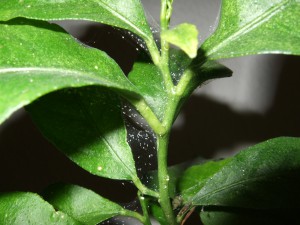
Spider mites are very tiny insects that reside on the underside of plant leaves, plants that are infested with these insects normally have spider webs and take on a dusty greyish appearance. To see if you have spider mites place a sheet of white paper under the leaves.
Shakes the leaves and if there is a spider mite infestation you will see tiny specks or spots moving around on the paper. You may even feel them crawling around on the surface of your skin. Their life-cycle consists of egg, larva, and two nymph stages. Spider mites can be controlled with insecticidal soap, horticultural oil, or neem oil.
Crucifer flea beetle control
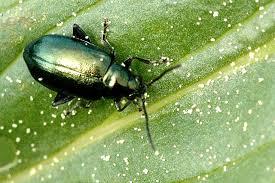
These beetles are small and dark jumps like fleas and congregate mostly in edible gardens. The adult beetles will chew round holes in the leaves, the larva however will feed on the roots. Ensure that all leaf litter is raked up along with other debris, the use of neem oil, Rotenone, Pyrethrin, etc.. has been known to be effective.
The final word on spring garden pests control
During the spring months when everything is alive and in full bloom gives such a wonderful feeling as we sit back and reap the rewards of a beautiful flower garden or eat the fruits of our labor as we reap a bountiful harvest from our edible gardens. Don’t let these garden pests rob you of the time and the money that was invested to achieve the desired results. Strike back with these control measures that have proven to be effective.
About the author
Norman loves being in the garden, both at home and for his job....
he is 'Natures Little helper' being outdoors, growing his vegetables and flowers from an early age.
Now having spent over 22 years in the profession he want to give some of his knowledge to others...
his vast array of hints and tips you will find scattered over this site will help you no end growing plants in your garden.

Hello! I just finished reading your article about How To Control Spring Garden Pests. I thoroughly enjoyed reading it! My dad always grows a summer vegetable garden, and I had always wondered what some of the pesky pests were that wreaked havoc on some of his vegetable plants. In particular, I have always noticed the leaves of his zucchini plants always get holes in them. What type of pest might do this? I’m really glad I read your article because as Spring is soon ending and we are heading into summer I am starting to prepare for planting my own small vegetable garden and it’s good to know about the kinds of pests I might be encountering once my plants start to grow and bear vegetables.
Thank You for such a lovely, and informative article about garden pests and how to control them.
Hello so happy to meet you and I am so glad that you found my article to be informative. Thank you so much for stopping by and commenting. This post should offer help, https://gardenofedengardencent…